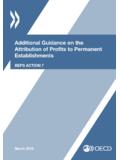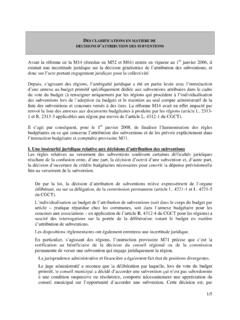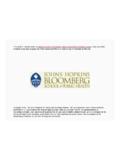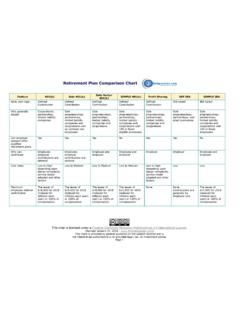Transcription of ATTRIBUTION OF PROFIT TO A PERMANENT ... - OECD.org
1 TAX AND commerce @OECDATTRIBUTION OF PROFIT TO APERMANENT establishment involved INELECTRONIC commerce TRANSACTIONSA DISCUSSION PAPER FROM THE TECHNICAL ADVISORY GROUP ON MONITORING THEAPPLICATION OF EXISTING TREATY NORMS FOR THE TAXATION OF BUSINESS PROFITSF ebruary 2001 DRAFT FOR PUBLIC COMMENTD eadline: 30 June 20012 TABLE OF CONTENTSF oreword ..3 Executive summary ..3 Introduction ..5 General principles for attributing PROFIT to a PERMANENT establishment ..6 Article 7(1) Calculating PROFIT to be allocated to a PERMANENT Model Convention ..8 Article 7(2) of the OECD Model Tax Convention ..8 First step: Determining the characteristics and functions of the hypothesised distinct and separate enterprise ..8 Second step: Determining the profits of the hypothesised distinct and separate enterprise based upon a comparability analysis ..9 Article 7 (3) of the OECD Model Tax Convention ..11 Special considerations in attributing PROFIT to a PERMANENT establishment in an electronic commerce environment.
2 11 Server creates a PERMANENT establishment ..11 Variation 1: Single considerations ..13 First step: Determining the conditions of the hypothesised distinct and separate enterprise ..13 Second step: Determining the profits of the hypothesised distinct and separate enterprise ..18 Application of transfer pricing methods ..23 Conclusion ..25 Variation 2: Multiple servers ..27 Server is part of an existing PERMANENT 3: Technical support staff in PERMANENT establishment ..28 General considerations ..29 Functional analysis and conditions of the hypothesised distinct and separate enterprise ..29 Application of transfer pricing methods ..30 Variation 4: Web site fully developed in PERMANENT considerations ..31 Functional analysis and conditions of the hypothesised distinct and separate enterprise ..31 Application of transfer pricing methods ..32 Conclusions .. date, much attention has been focused on the question of in what circumstances doelectronic commerce activities, especially the operation of a server in a particular jurisdiction, lead tothe recognition of the existence of PERMANENT establishment in that jurisdiction (the threshold question)under Article 5 of the OECD Model Tax Convention.
3 Indeed, the Committee on Fiscal Affairs hasrecently published a Report adding to the existing Model Commentary on Article 5 to clarify theapplication of the provisions of the Article in respect of web sites and servers. The clarification will beincorporated in the next update of the Model Tax that the threshold question has been settled, at least in respect of the application of theexisting rules, attention turns naturally to what profits can be attributed to e- commerce activities thathave passed the threshold of Article 5 so that a PERMANENT establishment is held to exist. The allocationof the taxing rights between the jurisdiction of the enterprise and the jurisdiction of the permanentestablishment are determined under Article 7 of the OECD Model Tax Convention. This discussionpaper is a first attempt at exploring the interpretation and application of Article 7 to a PE carrying onretail e- commerce activities ( e-tailing ).
4 Discussion paper has been produced by the Technical Advisory Group on Monitoring theApplication of Existing Treaty Norms for the Taxation of Business profits ( Business profits TAG ).This group was set up to assist in implementing the Ottawa Framework Conditions with a mandate toexamine how the current tax treaty rules for the taxation of business profits apply in the context ofelectronic commerce and to consider proposals for alternative rules. This paper is a discussion draftonly and does not represent a consensus view of the government or business members of the BusinessProfits TAG. However, the intention of releasing the discussion paper is to stimulate debate on how toattribute PROFIT to a PERMANENT establishment in an e- commerce context. This should assist in theultimate development of an internationally agreed consensus on the interpretation and application ofArticle 7 amongst business, OECD Member and non-member , comments on this discussion paper are invited, and indeed, positivelyencouraged by 30 June 2001.
5 Areas where comments would be particularly welcome are referred todirectly in the text. Comments can be posted on the public EDG( (to register for the EDG, if you are not already a member,please see: ) or e-mailed to Jeffrey Owens, Head ofFiscal Affairs and copied to John Neighbour, Head of Transfer Pricing andFinancial Transactions Unit discussion paper from the Technical Advisory Group on Monitoring the Application ofExisting Treaty Norms for the Taxation of Business profits ( Business profits TAG ) provides adetailed analysis of the transfer pricing issues arising in attributing PROFIT to a PERMANENT establishmentinvolved in electronic commerce activities, in the context of an enterprise engaged in the retaildistribution of entertainment products ( e-tailing ). The paper provides an overview of the currenttreaty rules for attributing PROFIT to a PERMANENT establishment under Article 7 of the OECD Model TaxConvention.)
6 It also refers to the on-going work of the Committee on Fiscal Affairs in this area, whichis attempting to develop a common interpretation of Article 7 that is in accordance with thearticulation of the arm s length principle found in the Transfer Pricing Guidelines, and foreshadowssome of issues raised in the context of this review in the Discussion Draft on the ATTRIBUTION of Profits4to PERMANENT Establishments1, a discussion paper issued on 8 February 2001 by the Committee onFiscal Affairs (CFA). That document looks at issues relating to the ATTRIBUTION of profits to permanentestablishments in general and is not confined to PERMANENT establishments in the e- commerce sector( CFA general discussion draft ). paper illustrates the various steps of the analysis that are required to attribute PROFIT to apermanent establishment , in the context of a specific example of an enterprise distributing productsover the internet through a web site hosted on a server situated in a PERMANENT establishment inanother country.
7 Four different variations of the example are developed and analysed. The firstvariation is the extreme case of a stand-alone computer server performing automated functions (inparticular, online processing of transactions and transmission of digitised products) without thepresence of personnel in the PERMANENT establishment . The second variation examines the case ofmultiple servers performing identical tasks. The third variation assumes the presence of personnel inthe PERMANENT establishment to provide online services and maintain the server. The last variationassumes that the development of the hardware and software used by the PERMANENT establishment wasentirely performed in the PERMANENT paper provides an analysis of the likely outcome of the application of the arm s lengthprinciple to the four examples and identifies some issues arising under the current interpretation ofArticle 7 that may prevent, in certain circumstances, a PROFIT ATTRIBUTION to the PERMANENT establishmentthat is fully consistent with the arm s length principle.
8 These issues are developed more fully in theCFA general discussion summary, it is found that the under the arm s length principle, the amount of PROFIT to beattributed to the PERMANENT establishment will be related to the nature of the functions that it performs(taking into account the assets used and risks assumed). Given the importance of intangible assets inthe earning of profits from e- commerce activities, it is also be essential to determine which part of theenterprise economically owns or has created the intangible assets used by the permanentestablishment. In the context of the stand-alone computer server (and the multiple server variation),the functional and factual analysis is likely to show that the PERMANENT establishment is performingonly routine functions and is reliant on other parts of the enterprise to provide the intangible assetsnecessary for it to perform most, if not all, of those functions.
9 Accordingly, the activities of thepermanent establishment are very unlikely to warrant it being attributed with a substantial share of theprofit associated with the distribution activities of the enterprise conducted through the server. Further,it is suggested that the nature of this type of server- PERMANENT establishment , especially its lack ofpersonnel, is likely to mean that tasks performed by the server would likely be conducted under a contract service provider arrangement that would leave all substantial assets and risks with the headoffice and attribute to the PERMANENT establishment the profits associated with the physical operation ofthe computer server. Under an alternative interpretation of the arrangement, whereby the permanentestablishment is considered to be instead an independent service provider , the conclusion would besimilar, given the need for the PERMANENT establishment to recognise, in computing PROFIT , the arm slength value of the tangible and intangible property that it uses and that were contributed to it by otherparts of the personnel are present in the PERMANENT establishment to perform maintenance andonline services tasks, the quantum of the PROFIT attributable to the PERMANENT establishment would becommensurate with what independent service providers would be expected to earn in a similar 1.
10 See for a link to the Discussion Draft on the ATTRIBUTION of profits toPermanent Establishments, posted 8 February Finally, the last variation (in-house development of server and web site) is likely to producea more substantial ATTRIBUTION of PROFIT to the PERMANENT establishment , as it assumes sufficientdevelopment risks to be considered as the economic owner of the intangible property developed tooperate the server and the web site and, therefore, is entitled to the PROFIT associated with theexploitation of such discussion paper is limited to an analysis of an e-tailing situation. The implicationsfor Article 7 of the transfer pricing issues raised by other business models could warrant further paper is also limited to an analysis of transfer pricing issues and does not address issues ofcompliance or other administrative aspects.


















